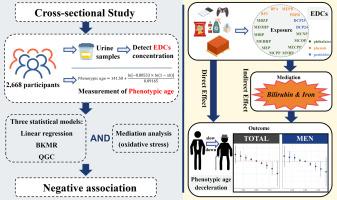Unveiling the mediating role of oxidative stress in the association between endocrine-disrupting chemicals and phenotypic age acceleration: a cross-sectional study
IF 2.7
引用次数: 0
Abstract
Aging presents a significant global public health challenge, raising concerns about environmental factors. However, evidence linking multiple endocrine-disrupting chemicals (EDCs) to aging and their mechanisms is limited. This study explored the link between ten phthalates, four phenols, and two pesticides and biological senescence, along with oxidative stress's regulatory role. This cross-sectional study analyzed data from the National Health and Nutrition Examination Surveys (2005-2016) with 2668 participants and sixteen chemicals. It used multiple linear regression, Bayesian kernel machine regression (BKMR), and quantile g-computation (QGC) to explore the relationships between EDCs and phenotypic aging, as well as the mediating effects of oxidative stress. Multiple linear regression indicated that MCNP, MECPP, MEHHP, and MEOHP were linked to decreased phenotypic age acceleration (PAA). BKMR analysis showed that phthalates significantly impacted both the total population and men, with group PIP values of 0.6335 and 0.8546, respectively. QGC results confirmed negative confounding effects (Estimation [95 % CI]: -0.79 [-1.31, -0.27] for the total population; -0.89 [-1.65, -0.13] for men). Both models identified MECCP and BP3 as key contributors. Mediation analyses revealed that bilirubin and iron mediated the relationship between the chemical mixture and PAA, with proportions of -24.86 % and -21.06 %, respectively.Our findings suggest that exposure to EDCs, both individually and in combination, is linked to slowed aging, particularly with MECCP and BP3. Additional laboratory and multicenter studies are needed to validate these results.

揭示氧化应激在内分泌干扰化学物质和表型年龄加速之间的中介作用:一项横断面研究
老龄化是一项重大的全球公共卫生挑战,引起了人们对环境因素的关注。然而,将多种内分泌干扰化学物质(EDCs)与衰老及其机制联系起来的证据有限。本研究探讨了十种邻苯二甲酸酯、四种酚类和两种农药与生物衰老之间的联系,以及氧化应激的调节作用。这项横断面研究分析了来自国家健康和营养调查(2005-2016)的数据,有2668名参与者和16种化学物质。采用多元线性回归、贝叶斯核机回归(BKMR)、分位数g计算(QGC)等方法探讨EDCs与表型衰老的关系,以及氧化应激的中介作用。多元线性回归表明,MCNP、MECPP、MEHHP和MEOHP与表型年龄加速(PAA)降低有关。BKMR分析显示,邻苯二甲酸酯对总人口和男性均有显著影响,组PIP值分别为0.6335和0.8546。QGC结果证实了负混淆效应(估计95% CI:总人口-0.79[-1.31,-0.27];男性-0.89[-1.65,-0.13])。两个模型都认为MECCP和BP3是关键的贡献者。调解分析表明,胆红素和铁分别以- 24.86%和- 21.06%的比例介导了化学混合物与PAA的关系。我们的研究结果表明,暴露于EDCs,无论是单独的还是联合的,都与延缓衰老有关,尤其是MECCP和BP3。需要更多的实验室和多中心研究来验证这些结果。
本文章由计算机程序翻译,如有差异,请以英文原文为准。
求助全文
约1分钟内获得全文
求助全文
来源期刊

Hygiene and environmental health advances
Environmental Science (General)
CiteScore
1.10
自引率
0.00%
发文量
0
审稿时长
38 days
 求助内容:
求助内容: 应助结果提醒方式:
应助结果提醒方式:


